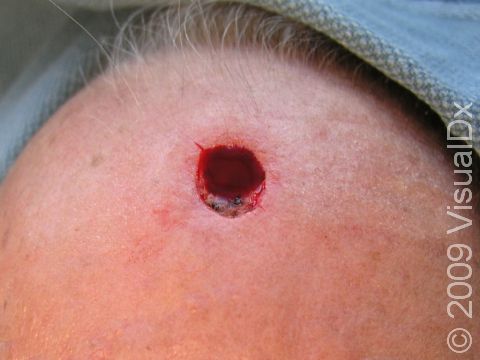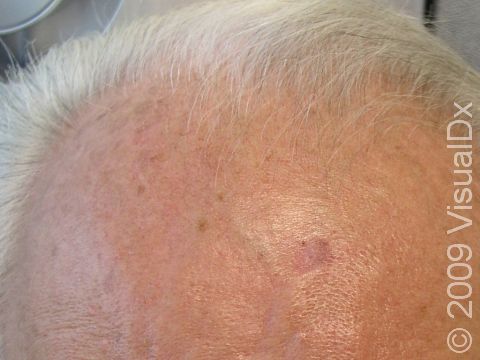Mohs Micrographic Surgery
Mohs micrographic surgery, often simply called Mohs surgery, is a technique used in the treatment of certain skin cancers. The procedure has a high cure rate, allowing for complete removal of the skin cancer while minimizing removal of healthy surrounding skin. Any location on the body can be treated with Mohs surgery, but it is typically reserved for skin cancers occurring on the:
- Ears.
- Face.
- Lips.
- Scalp.
- Any sensitive location on the body that would have a higher risk of complications with regular surgical excision.
Skin cancers removed typically include:
- Basal cell carcinoma.
- Squamous cell carcinoma.
- Skin cancers with ill-defined borders.
- Skin cancers with high recurrence rates.
- Certain early melanomas.
Mohs surgery is typically done by a dermatologist who is specially trained as a Mohs surgeon.
What to Expect During Your Visit
Prior to beginning the procedure, your Mohs surgeon will discuss the approach to both the procedure and the repair. This may be done in a separate consultation appointment or may be done prior to beginning the surgery in the same visit. For skin cancers on the eyelid, the Mohs surgeon might recommend that an ophthalmic plastic surgeon perform the repair.
The area to be removed is first cleaned and prepared for surgery. A needle is used to inject anesthetic into the skin to numb the area. A scalpel is used to remove a thin layer of visible skin cancer tissue plus a very small margin of normal-appearing skin. Each area of skin that is removed is frozen and then cut into small sections.
Each frozen section is then examined under the microscope. If cancerous cells remain on any one of the frozen sections, a new layer is excised, guided by precise mapping techniques that allow for exact localization of the remaining tumor. This is repeated until no more cancer remains. Because one or more stages may be necessary to completely remove the skin cancer, it is a more time-consuming technique compared to a typical surgical excision.
Once the margins are clear, meaning no more skin cancer is found under microscopic examination, the Mohs surgeon will then repair the wound or determine if it can be left open to heal. The choice of closure technique and repair depends on the location and size of the wound. When the wound is closed, a pressure dressing is applied. The medical professional will let you know if nondissolving sutures have been used, which will need to be removed in 7-14 days.
What to Expect After Your Visit
Following Mohs surgery, there may be minor oozing or bleeding. If so, apply a clean gauze pad to the area and place pressure on it for 5-10 minutes. There may be pain after the local anesthetic wears off, but this is usually easily controlled with pain reliever such as acetaminophen (eg, Tylenol). There may also be bruising.
A small scar will occur where the incision was made.
Follow-Up Care
The medical professional will discuss wound care follow-up.
Generally, follow-up care includes:
- Keeping the skin dry during the first 24-48 hours.
- Applying petroleum jelly (eg, Vaseline) or antimicrobial ointment daily.
- Keeping the area covered with gauze dressing or an adhesive bandage.
If you need to have sutures removed (ie, you did not have the absorbable kind), be sure to follow up with your Mohs surgeon.
Risks and Potential Side Effects
Mohs surgery is a precise technique with a high cure rate, and it will leave the smallest scar possible. There are some risks, though, including:
- Infection.
- Bleeding during or after the surgery.
- Bruising.
- Scarring, such as a keloid, or a thick (hypertrophic) scar.
- Visible stitch marks where sutures were placed.
- Cutting important structures such as vessels or nerves, depending on the location and size of the lesion.
When to Seek Medical Care
See your medical professional if you develop signs of infection (such as pain, spreading redness, or fever) or a large bruise beneath the skin.
It is important to follow up with your regular dermatologist, as well, at regular intervals for further skin checks to look for any new skin cancers that may be present.
Trusted Links
References
AAD. What is Mohs surgery?. American Academy of Dermatology. https://www.aad.org/public/diseases/skin-cancer/types/common/melanoma/mohs-surgery. Updated 2021 May 17. Accessed 2024 Apr 5.
Skin Cancer Foundation. Mohs surgery: the most effective technique for treating common skin cancers. Skin Cancer Foundation. https://www.skincancer.org/treatment-resources/mohs-surgery/. Updated 2022 Jun. Accessed 2024 Apr 5.
Last modified on May 14th, 2024 at 10:55 pm

Not sure what to look for?
Try our new Rash and Skin Condition Finder


